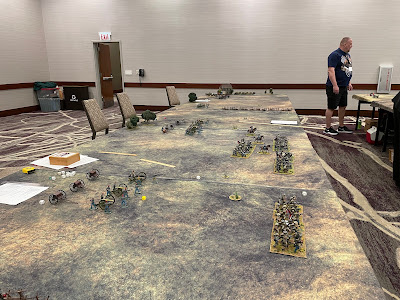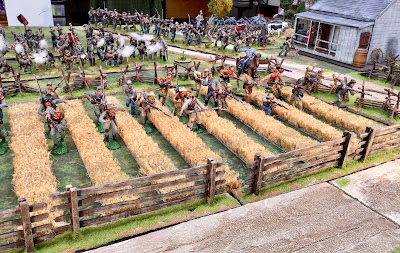 |
| Wheatfield made from a coir doormat |
My Pickett's Charge game stretches out over three 6ft by 20ft tables. One of the things that I noticed in my previous playing of the game is that the third table (the Confederate back table) looks a bit sparse after the Confederates march off of it and on to the middle table and the Emmitsburg Road.
 |
| The Confederate back table during the game at Little Wars this year. Look at all of that empty table space once the Confederates move off of the table. |
 |
| The middle table features the Emmitsburg Road and it has more visual things going on than there is one the Confederate back table. |
I decided that I need to add some terrain pieces to the back table so that it doesn't seem so bare. I considered using teddy bear fur to make some amber waves of grain on the back table, but I have never made a bear fur mat, it would be cumbersome to carry to the convention, and it seemed like too much effort and not enough payback to do. So I decided to create some areas of wheat fields for the back table.
 |
| Doormat strips are glued to cork bases and terrained with goop. |
The typical material for such a field is to use a sisal or coir doormat like you might use for your front door to your house. I picked one up at the local Big Box store for about $10.00. Gamers often cut the mats up into rectangular pieces and set them out on the table. The problem with this is that the field just looks like a giant piece of doormat, which is what it is.
So my next thought was to cut the doormat into one-inch wide strips and place them on the table about one inch apart from each other. This would break up the single piece look of just cutting up a large section of doormat and placing it on the table. This adds a three dimensional look to the wheat field, however, I didn't like leaving bits of the green table mat exposed beneath the wheat strips. So I cut out some bases for the strips of wheat grass (2-inches wide for the 1-inch strip of door mat) and then added my usual mixture of "goop" wallboard past mixed with brown paint and let it dry overnight. The next day I did some dry brushing of the bases with a tan color called "Camel". The final touch was to cut the threads off of some of my doormat offcuts and sprinkle them over the wheat field bases like you would if you were flocking a base of war game figures. I used Elmer's spray adhesive along the sides of the bases and sprinkled the bits of coir threads on the surface. After doing this task on all of the strips, I then placed them together, side by side, and sprayed adhesive over the surface of all of the strips. This reduces the appearance of the strips as pieces of door mat and adds a little more texture to the top of the wheat field strip.
 |
| The strips of doormat have not been based at this point, they are merely set up on top of the game mat. The sections of green do not do much for the overall appearance. |
 |
| The finished strips of wheat field made from a door mat. |
I might have done the wheat field pieces in a different way had I been using them for 28mm figures.
Here is a picture that I pulled off of the internet showing a different way of making grass or wheat fields for smaller 28mm figures. The irregular shapes look good and they can be moved around as the war game units move through it.
In my situation though, I am not anticipating any of my Confederate regiments marching through wheat fields so they don't have to be done in the manner shown in the above picture. My wheat fields are "for looks" only and their purpose is to fill up blank space on the back table. I will also add a farmhouse in the corners of the back table as vignettes of interest and this should help steer the eye around the table.








No comments:
Post a Comment